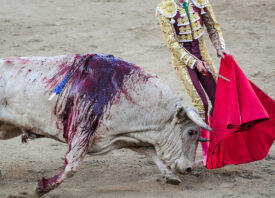Search this site
The Bittersweet Story of Abbey, a Beagle Rescued from Research


For the first year of her life, Abbey the beagle lived in a small dog run at a veterinary school, where she was used as a teaching candidate for the spay program. Sometimes, she was given occasional walks by volunteers, but she never left the university. The photojournalist Jo-Anne McArthur met Abbey in 2012, the year she was rescued by a woman named Melanie. Her time as a research subject had ended, and she became a family dog.
“On the day of her adoption, Abbey was quiet, withdrawn, and tentative,” McArthur, the founder of the organization We Animals Media remembers. “That is–until she got to romp in the sun in the backyard with the family’s other rescued beagle, Maggie. It was incredible to see them running together. Abbey’s adoption was beautiful but also bittersweet. The adopters were there at the lab, meeting beagle after beagle, having to choose just one. A hard decision! And always with the hopes that all the others would be adopted out to good homes.”

Machine / We Animals Media
Melanie, Abbey’s adopter, remembers their first car ride home vividly. “Abbey’s ride to freedom was heartbreaking for me, but we got through it, and she eventually found herself trusting us,” she tells me. “For years, both girls–Abbey and Maggie–never made a sound, and we initially thought they’d been devocalized.” After some time with Melanie, however, they felt comfortable enough to bark for the first time–a welcome and precious sound.


Most research dogs are euthanized after their brief lives in labs, so Abbey was one of the lucky ones. According to the American Anti-Vivisection Society, beagles are regularly used for biomedical research on cancer, heart and lung disease, and orthopedics. Vet schools have traditionally used dogs for student training and surgeries, though increasingly, these schools are choosing alternatives that do not harm animals.
As McArthur learned from speaking with experts like Dr. Theodora Capaldo, then president and executive director at the New England Anti-Vivisection Society (NEAVS), beagles are regularly used for research due to their size as well as their docile, non-aggressive personalities, created by decades of selective breeding. Their gentleness makes them easier to exploit, and their small size means they cost less to house.
Abbey was rescued from a vet school in Canada, but across the United States as well, dogs are still being used for pharmaceutical research, pesticide research, and more. Many do not survive. For instance, a 2019 uncover investigation from the Humane Society of the United States, carried out at a laboratory in Michigan, revealed that twenty beagles, including a friendly and mild-mannered boy named Harvey, had been killed during a study.
The dogs in that Michigan facility had been force-fed, given drugs, and subjected to invasive surgeries. Harvey’s chest had been opened, and chemical substances had been poured inside. He bore a large surgical scar. The day he was euthanized, he was allowed a few minutes to run on the floor outside of his cage. For all the dogs whose stories we hear–the unlucky ones like Harvey and the fortunate ones like Abbey–there are others who remain invisible and hidden behind closed doors.
When Abbey was rescued, McArthur was surprised to learn that she had never used stairs during her time at the university. She had to be taught how to walk up and down. “Both Abbey and Maggie had to overcome their own set of problems–trust being the biggest–but both turned into the most loving, cuddly, beautiful dogs,” Melanie says today, almost a decade after Abbey’s adoption. “Maggie has always been our little miss independent, while Abbey was always her shadow–constantly close by, grooming her.”

Maggie passed away last year after a long and happy life with Melanie. Abbey is ten years old now; her hearing and eyesight have faded, but she’s healthy and safe and loved. “Abbey, to this day, still mourns Maggie,” Melanie admits. “I’ve always said that Maggie and Abbey saved me as much as I saved them. Life threw us some twists and turns, and throughout it all, both have been my consistent support system. They always knew when I needed them by my side.”


McArthur met Abby while filming The Ghosts in Our Machine, the 2013 documentary following her work as animal photojournalist, directed by Liz Marshall. This story is part of a series of articles about the We Animals collection, a world-class stock site comprising more than 10,000 images and videos from animal photojournalists working around the world. You can support their work by making a one-time donation here, or you can become part of We Animals Allies here.
